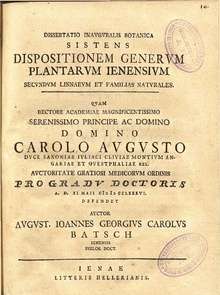August Batsch

August Johann Georg Karl Batsch (28 October 1761 – 29 September 1802) was a German naturalist. He was a recognised authority on mushrooms, and also described new species of ferns, bryophytes, and seed plants.
Life and career
Batsch was born in Jena, Saxe-Weimar to George Lorenz Bratsch and Ernestine (nee Franke) Bratsch. He studied at the city school, and then had private tuition. He showed an aptitude for natural sciences, and so subsequently studied at the University of Jena (now known as the Friedrich Schiller University of Jena), entering in 1772 and obtaining his doctorate in 1781.[1] Batsch was married in 1787 to Amalie Pfaundel. They had three children, Friedrich (born 1789), George Friedrich Karl (1792), and Karoline (1795). He died in 1802 after a short illness.
In 1786, he obtained a further doctorate in medicine, and began to teach natural history at the university the same year.
In 1787, he began teaching medicine at the university. In 1792, became Professor of Philosophy. He advised Johann Wolfgang von Goethe on his botanical research.
In 1790, Batsch founded a botanical garden in Jena, and the Naturforschende Gesellschaft ("Nature Investigator's Club").[2]
Botany

Batsch discovered almost 200 new species of mushrooms, including Clitocybe nebularis, Calocera cornea, Paxillus involutus, and Tapinella atrotomentosa. He was a recognised authority writing two books on the topic, Elenchus Fungorum (Discussion of Fungi, between 1783 and 1789), which is still highly rated today[3] and Versuch einer Anleitung zur Kenntniss und Geschichte der Pflanzen (Attempt at Instruction in the Knowledge and History of Plants, between 1787 and 1788). Versuch einer Anleitung... looked into the nature of what we now know to be fungal diseases of plants (such as Dutch elm disease), but without realizing their origin.
Other works include Dispositio Generum Plantarum Jenensium Secundum Linnaeum et Familias Naturales, Jena 1786, generally referenced as Dispos. Gen. Pl. Jenens., alternatively titled as Dissertatio inauguralis botanica sistens dispositionem generum plantarum Jenensium.[4]
Zoology
Batsch wrote Versuch einer Anleitung, zur Kenntniß und Geschichte der Thiere und Mineralien, für akademische Vorlesungen entworfen, und mit den nöthigsten Abbildungen versehen, in English Provisional guide to the knowledge, development and history of the animals and minerals, designed for academic lectures.The first part (Erster Theil) Allgemeine Geschichte der Natur; besondre der Säugthiere, Vögel, Amphibien und Fische German natural history, mammals,birds amphibians and fish appeared in 1788.Part two (Zweyter Theil). Besondre Geschichte der Insekten, Gewürme und Mineralien on insects, worms and minerals was published in the following year, 1789.
See also
References
- ↑ Verein der Familie Batsch e.V. (German)
- ↑ August Johann Georg Karl Batsch (1761 - 1802)
- ↑ "Elenchus Fungorum is not only important for its taxonomic value (Batsch describes about 200 species in it), but is also a good Flora study and is even today of great worth", Heinrich Dörfelt & Heike Heklau (1998) Die Geschichte der Mykologie (The Story of Mycology)
- ↑ Dispos. Gen. Pl. Jenens. 1786
- ↑ IPNI. Batsch.
External links
- Plate Plate from Elenchus fungorum.
- Text of Elenchus Fungorum (German)
- University of Jena botanical garden
- Texts of works available at BHL